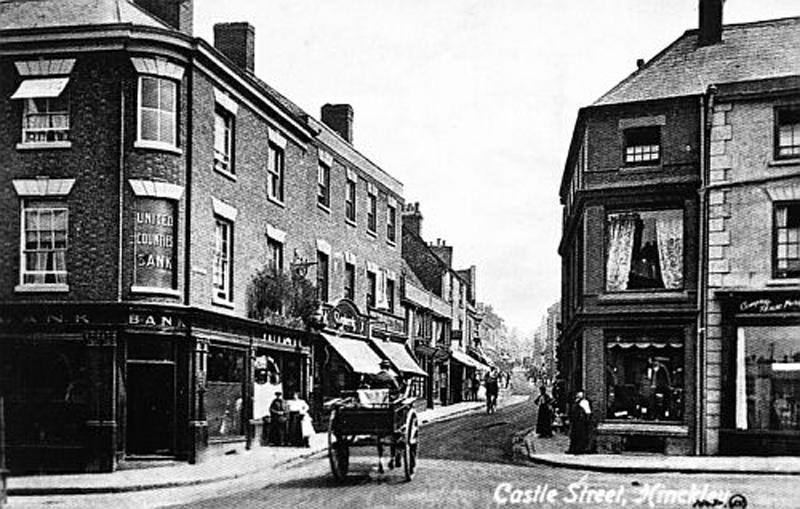Hinckley
The Anglo Saxon placename for Hinckley suggests something about its origins. Hinckley or 'Hynca's leah' means 'woodland clearing of a man called Hynca'.

County: Leicestershire
Population (2001): 100,141
During Norman times the settlement was considered a strategic location and a wooden castle was built on an area of high ground to the side of modern day Castle Street. A late eleventh century priory was also built in the town. Hinckley developed into a small market town holding markets and annual fairs. In 1260 while Simon de Montfort owned Hinckley, it was declared a town where 'strangers might buy or sell wool without a fine'.
In 1640 William Iliffe made an introduction to the town that was to change its future. He bought a knitting frame for the substantial sum of £60 and set it up in his house, thought to be located at the top of Castle Street. Other framework knitters (the Wood and Woodward families) followed Iliffe and set up as framework knitters. A Hinckley man by the name of Needham was recorded in 1670 as having made improvements to the knitting frame. By the end of the seventeenth century the Iliffe family together with the Wards and Hursts were established hosier families in Hinckley.
In 1640 William Iliffe made an introduction to the town that was to change its future. He bought a knitting frame for the substantial sum of £60 and set it up in his house, thought to be located at the top of Castle Street. Other framework knitters (the Wood and Woodward families) followed Iliffe and set up as framework knitters. A Hinckley man by the name of Needham was recorded in 1670 as having made improvements to the knitting frame. By the end of the seventeenth century the Iliffe family together with the Wards and Hursts were established hosier families in Hinckley.
Hinckley's population by the start of the eighteenth century had reached around 2,000. People worked their allocation of land and earned additional money by framework knitting in their spare time. An Act of Parliament was passed in 1759 that approved the enclosure of Hinckley's open fields. The process of enclosure reallocated land, moved some families out of the town centre, left some families with little or no land, and the town's stock of former agricultural buildings only partially used. Framework knitting provided a solution for abandoned farm buildings and families left without a livelihood after enclosure. The town soon gained a reputation for its fully-fashioned cotton stockings. Felkin recorded that within twenty years of enclosure Hinckley had 864 knitting frames worked by 1,000 framework knitters and supported by 1,150 ancillary workers.
By the start of the nineteenth century Hinckley's population had reached 5,158 (1801). The Ashby Canal opened in 1804 providing a link from Hinckley to the Coventry Canal and Midlands canal network beyond. Like many other East Midlands towns, Hinckley suffered from the downturn in the stocking trade following the Napoleonic wars. The fashion for trousers rather than breeches meant that high quality stockings, the main product of Hinckley's industry, fell in demand. Oversupply of labour and a further fall in stocking prices in the 1830s prolonged difficult times in Hinckley. Occasional outbreaks of violence were recorded throughout this time, but the town escaped the worst of the Luddite riots experienced elsewhere.
Frameshops and factories were slow to emerge in Hinckley compared with other towns in the region. The popularity of narrow frames in Hinckley meant that workers were able to continue knitting in their own homes. The 1836 Parish Rate Book makes the earliest known reference to a factory in the town. The building was located on Upper Bond Street and provided accommodation for hand operated knitting frames. Thomas Payne opened the town's first steam-powered factory in 1855. Sited between Castle Street and Wood Street, the factory's steam engine powered 40 circular machines. Factory production did not bring about an immediate end to domestic working and many continued to work at home on hand frames and Griswold circular machines. Business in the Hinckley industry was helped by the arrival of the railway in 1862.
Hinckley Technical College was founded in 1891 to provide education relevant to the 'trades of the town'. The College's knitting courses were considered particularly important and a Hosiery Committee of leading figures from the industry and the community was established to advise the College. Around 40 to 50 students studied framework knitting each year.
Hinckley's knitting industry had expanded to 25 factories by the start of the twentieth century. This figure had more than doubled by the time of World War II. A job in the knitting industry was the usual expectation for most Hinckley school leavers. Over the same period the town's population increased from 9,600 to 32,000. Slums were knocked down and new council houses were built to provide accommodation for the population.
The town's knitting industry continued to expand and prosper until the 1970s. Recession and global competition have forced many companies to close or downsize. Some companies have found niche markets that provide continued demand for their products. In the late twentieth century new employment opportunities arose as diverse industries located themselves in units on Harrowbrook, Dodwells Bridge, Sketchley Lane and Hinckley Fields industrial estates.
The history of the town and its knitting industry are now told in the Hinckley & District Museum.